Pros
Cons
Introduction
Product Overview
{{section_header}}{{section.name}}{{/section_header}}
The {{product.name}}s are a set of very light in-ear headphones with a microphone near the cable split for smartphone users.
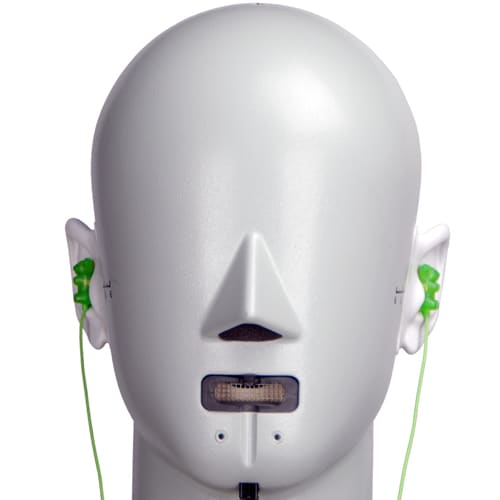
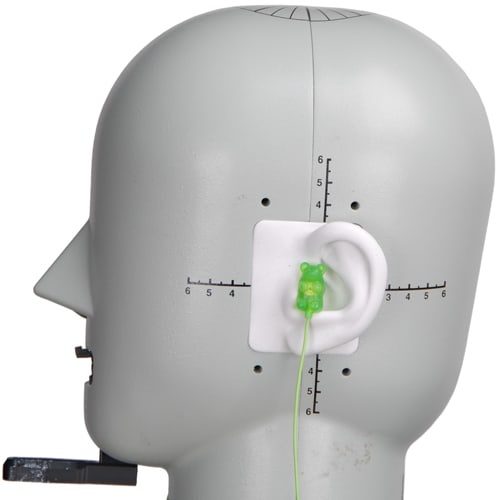
Speakers
{{section_header}}{{section.name}}{{/section_header}}
Here we see the speaker element of the {{product.model}}s, guarded by a somewhat porous mesh.
Back
{{section_header}}{{section.name}}{{/section_header}}
Though these in-ears are relatively small, what surface area they do have is packed with black and chrome styling.
Cable
{{section_header}}{{section.name}}{{/section_header}}
V-Moda put a considerable amount of time and effort into developing the cables for the {{product.model}} and other headphones released in 2010 and 2011. Underneath that fabric eave on the outside of the 3.93-foot cable is a layer of kevlar to shield the wire. All in all, an insanely durable cable.
At the end of said ridiculously durable cable is the oddly-angled plug. Using the standard 1/8th inch plug, the {{product.model}}s surprisingly don't have a very thick or robust assembly housing the plug itself.
The cord guards on the earbuds are very small wrappings of soft rubber, but they seem to do the trick; just avoid yanking your {{product.model}}s out by the cords, despite how tempting it may be to do so.
Additional Features
{{section_header}}{{section.name}}{{/section_header}}
Right at the neck split is a microphone that allows smartphone users to employ their {{product.model}}s as a headset, granting the ability to chat over Skype or a regular phone call.
In the Box
{{section_header}}{{section.name}}{{/section_header}}
Packaged along with your sleek-looking earbuds are seven pairs of sleeves, a carrying case, and helpful documentation (including a guide to Noise-induced Hearing Loss).
Durability
{{section_header}}{{section.name}}{{/section_header}}
While the cable itself is durable, there re several points at which it can't be saved by its comically robust shielding; namely solder points and inside the cable guards are slightly vulnerable. Keep in mind that if anything's going to break, it's typically the cables that break first. Though that's an unlikely event with these, be aware that if anything happens to them, you'll need a new pair.
Aesthetics
{{section_header}}{{section.name}}{{/section_header}}
With a black casing and chrome accents, these earbuds, while small, pack a lot of style per square inch. {{product.model}}, get ready for your closeup.
Frequency Response
{{section_header}}{{section.name}}{{/section_header}}
When we look at a frequency response graph, we score based on how well the headphones reproduced frequencies within certain limits. Still, different consumers want different things in their headphones, and it's not too uncommon to run across someone who loves it when their cans emphasize certain frequencies over others. Note how the lower frequencies (bass frequencies) are emphasized much more over the rest; for those who love bass, these are good headphones to pick up. For reference, these rival the Monster Beats Pros.

Click here for more information on our frequency response test.
Distortion
{{section_header}}{{section.name}}{{/section_header}}
No headphone has reached what we deem "perfect" so far, and the {{product.model}}s are no different: they seem to have a little bit of distortion, but nothing that you're likely to hear.
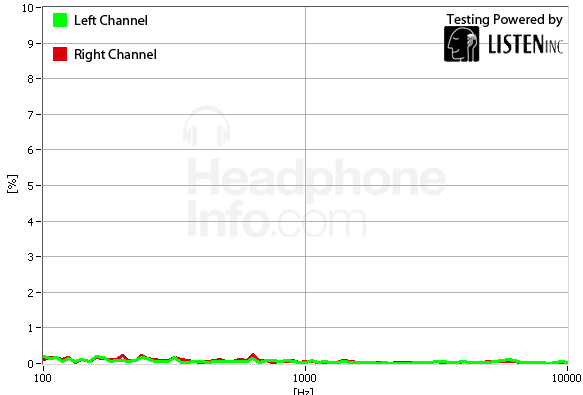
Click here for more information on our frequency response test.
Tracking
{{section_header}}{{section.name}}{{/section_header}}
the {{product.model}}s have a fairly even tracking response, not shifting wildly from channel to channel. This graph isn't perfect, but unless your timpanic membranes are tighter than a kettle drum, you won't hear a 1dB shift in channel preference.
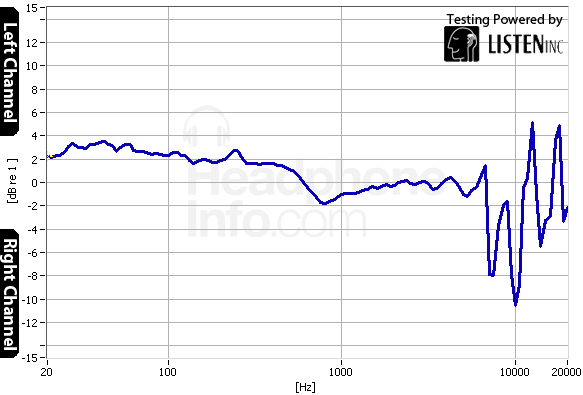
Click here for more information on our frequency response test.
Isolation
{{section_header}}{{section.name}}{{/section_header}}
We typically see in-ear headphones isolate the outside world very well, and these do very much the same: though they don't appear to block out a ton of low-end noise, we'd like to remind you that while our graphs go very high, your typical earplugs will give you about a 10dB reduction in noise, so these do a good job comparatively speaking.

Click here for more information on our isolation test.
Leakage
{{section_header}}{{section.name}}{{/section_header}}
Much like they block the outside world from reaching your ear canal, they also block the music in your ear canal from reaching the outside world, so listen to as much embarrassing music as you want! Nobody will hear it.
Click here for more information on our leakage test.
Maximum Usable Volume
{{section_header}}{{section.name}}{{/section_header}}
While the {{product.model}}s can pump out tunes at 118+dB without hitting 3% distortion, we'd like to remind you that listening to that level of volume is dangerous to your hearing, and you should really never do that sort of thing. If you'd like to find out a little more about why you shouldn't do this, read up on Noise-Induced Hearing Loss, or refer to the booklet on the subject included with the {{product.model}}s.
Click here for more on our maximum usable volume test
Short-Term Use
{{section_header}}{{section.name}}{{/section_header}}
In-ear headphones are essentially bits of plastic and silicon jammed into an orifice that wasn't meant to see any foreign objects, so you can imagine that there's always a risk of these things being a little uncomfortable if you don't know what to expect. That being said, the multiple sizes of sleeves and the soft material they're made out of reduce a lot of the pressure on the ear canal walls. Not to mention the fact that the included optional ear loops go a long way to evenly distributing the admittedly light weight of the buds over the back of your pinna, making these about as comfortable as in-ears can get.

Extended Use
{{section_header}}{{section.name}}{{/section_header}}
Over a period of 6 hours, some users may grow uncomfortable with these headphones, but we encountered no issues with several listeners.
Customizability
{{section_header}}{{section.name}}{{/section_header}}
Though these in-ears are too small for things like faceplates, the several different sleeves allow the user to find the best fit available for them. Beyond that, though, there isn't a whole lot to customize.
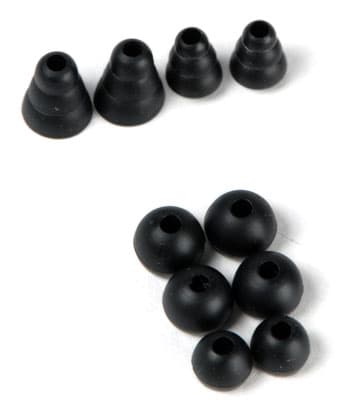
Cable Connectivity
{{section_header}}{{section.name}}{{/section_header}}
The {{product.model}}s have a standard 1/8th inch jack, with no adapters. That shouldn't be too much of a problem though, if you're using the {{product.model}}s with portable media players.
Portability
{{section_header}}{{section.name}}{{/section_header}}
As these in-ears are super light and have a leather carrying case, they are super-portable. You may not want to carry all 7 extra pairs of sleeves with you, but it will be easy for you to carry around these headphones without too much effort.
Maintenance
{{section_header}}{{section.name}}{{/section_header}}
The {{product.model}}s come with no cleaning tools, so maintenance will be an issue unless you either never expel earwax ever, or carry around rubbing alcohol with a cloth. That being said, the mesh gate should catch just about anything you could gunk it up with.
Other Features
{{section_header}}{{section.name}}{{/section_header}}
Remote & Mic
The remote is located on the right ear's cable, sporting volume up/down buttons, and an answer/end call button in the middle. It's a little difficult to operate when you have the optional ear loops installed, as it's close to the right ear's driver, but otherwise this remote is highly useful for smartphone users.
Design
{{section_header}}{{section.name}}{{/section_header}}
Though both sets of headphones are in-ears, that's about where the similarities end. Where the {{product.model}}s have soft silicon sleeves and small cables, the mc5s have somewhat more firm plastic sleeves, no remote or mic, and less durable cables. In the end it's up to you what you like in your headphone design, as there are tradeoffs to each.
Frequency Response
{{section_header}}{{section.name}}{{/section_header}}
Here is the biggest difference between the two. While the mc5s favor a very flat, even frequency response, the {{product.model}}s were designed with the bass lover in mind, boosting bass frequencies to an absurdly high level.
Distortion
{{section_header}}{{section.name}}{{/section_header}}
Neither headphone has much distortion, but the {{product.model}}s have a bit more.
Tracking
{{section_header}}{{section.name}}{{/section_header}}
Both in-ears are spot-on in terms of tracking.
Isolation
{{section_header}}{{section.name}}{{/section_header}}
While both do a decent job of noise attenuation, the mc5s offer an absurd amount of isolation, virtually guaranteeing that you hear nothing from the outside world.
Comfort
{{section_header}}{{section.name}}{{/section_header}}
While people have different heads and almost all headphones will feel differently to many people, we're going to go out on a limb and say that the {{product.model}}s are a bit more comfortable, as they go a long way to distribute their weight and make sure there is a sleeve size that's right for you.
Verdict
{{section_header}}{{section.name}}{{/section_header}}
Like many of our comparisons, this one's up to you. If you want superb isolation, don't care about a remote, and aren't crazy about hilariously overemphasized bass, grab the mc5s. Otherwise, we'd say that the {{product.model}}s are a good buy only a few bucks more expensive.
Design
{{section_header}}{{section.name}}{{/section_header}}
Despite the obvious differences between in-ear and on-ear headphones, the {{product.model}}s have a more instricate, more industrial look, while the Beats have a more uniform, plastic feel to them. We prefer metal-housed headphones, but style is a subjective comparison.
Frequency Response
{{section_header}}{{section.name}}{{/section_header}}
Though both frequency responses are quite similar, we're going to give the edge to the {{product.model}}s here, as they have a more even response among the mid-tones, and less underemphasis of audible frequencies.
Distortion
{{section_header}}{{section.name}}{{/section_header}}
Due to the active noise-cancelling feature of the Beats, the Beats have somewhat audible distortion, where the {{product.model}}s avoid this problem altogether.
Tracking
{{section_header}}{{section.name}}{{/section_header}}
Where the {{product.model}}s have a nice, even, and consistently good tracking response, that of the Beats reads like a seismograph. You'll notice this shortcoming right away.
Isolation
{{section_header}}{{section.name}}{{/section_header}}
Despite the fact that the Beats do manage to attenuate a fair amount of sound with their active noise cancelling, the {{product.model}}s do a better job (especially around the mid tones) across the board with their passive attenuation. We'd recommend those looking for isolation to stick with the {{product.model}}s.
Comfort
{{section_header}}{{section.name}}{{/section_header}}
Though a bit apples-and-oranges, the Beats are probably more comfortable for more users simply by nature of their design. That's not to say that the {{product.model}}s are uncomfortable, but in-ear headphones have a tendency to be uncomfortable for many people.
Verdict
{{section_header}}{{section.name}}{{/section_header}}
Considering the price difference, we're going to stick with the {{product.model}}s here. Not only do they have a better audio performance, but they're about half the price and have the ability to be used with a smartphone or tablet. Still, if you absolutely must have the Beats as a status symbol, don't let us stop you.
Design
{{section_header}}{{section.name}}{{/section_header}}
While by design the {{product.model}}s should be less durable, whenever we put on the AE2s, we can't help but feel like we might break them due to their cheap plastic housing. With the {{product.model}}s, we see cloth-ensconced, kevlar-reinforced cables with a metal earbud casing. Over-ear headphones tend to be more comfortable, but we like the design of the {{product.model}}s better.
Frequency Response
{{section_header}}{{section.name}}{{/section_header}}
While it's no secret that we're fans of flatter responses, and the {{product.model}}s have a huge bass response, they do manage to stay within our ideal limits better than the AE2s, which seem to like to underemphasize many mid-tones, and neglect higher frequencies. This one's a no-brainer.
Distortion
{{section_header}}{{section.name}}{{/section_header}}
Neither headphone has big problems with distortion, but the {{product.model}}s technically have less.
Tracking
{{section_header}}{{section.name}}{{/section_header}}
Neither headphone is perfect here either, but the channel shifts with the {{product.model}}s are less than audible, unlike those of the AE2s.
Isolation
{{section_header}}{{section.name}}{{/section_header}}
The {{product.model}}s offer much more isolation from the outside world than the AE2s, which really don't offer much attenuation at all.
Comfort
{{section_header}}{{section.name}}{{/section_header}}
The AE2s are very comfortable and light headphones, and the in-ear headphone design is anything but comfortable, but that's not to say that the {{product.model}}s will make you scream in horrific pain every time you put them in. It really depends on how they fit you, so try both before you buy if you can. We'll still give the AE2s this one, though.
Verdict
{{section_header}}{{section.name}}{{/section_header}}
Unless the slight downgrade in comfort is a huge deal to you, there's very little reason at all outside of a fire sale to buy the AE2s over the {{product.model}}s. Not only do the {{product.model}}s have a better frequency response, less distortion, the same MSRP, and a manufacturer guarantee backing their durability, the AE2s fall flat when it comes to overall performance, and lack the capabilities of the {{product.model}}.
Design
{{section_header}}{{section.name}}{{/section_header}}
Though both the IE 8is and the {{product.model}}s are in-ear headphones, they offer different maintenance options which are important to consider before plunking down a serious chunk of change on them. Where the {{product.model}}s reinforce their cables with kevlar, the IE 8is make sure you can replace your cables easily in the event of breakage. While the tank-like cables are nice to have, the ability to replace them greatly extends the life of in-ears, but it comes at a price reflected in the MSRP.
Frequency Response
{{section_header}}{{section.name}}{{/section_header}}
Both frequency responses are remarkably similar, with a few odd ranges of emphasis in the response of the IE 8is.
Distortion
{{section_header}}{{section.name}}{{/section_header}}
Neither set of headphones has much distortion, but the IE 8is have less.
Tracking
{{section_header}}{{section.name}}{{/section_header}}
Both headphones have a good tracking response, until you get to the highest end with the IE 8is, for some reason they have an oddly specific range of frequencies that are pumped out by the right channel, but it's so small that it's hard to notice.
Isolation
{{section_header}}{{section.name}}{{/section_header}}
Both headphones offer good isolation, as they're in-ears, but the {{product.model}}s technically block out more outside noise.
Comfort
{{section_header}}{{section.name}}{{/section_header}}
For in-ears, both sets are very comfortable, but as different people have different ear canals, we suggest trying them on for yourself if you have the opportunity to decide for yourself.
Verdict
{{section_header}}{{section.name}}{{/section_header}}
This one's a tossup. Buyers on a budget may like the reduced price of the {{product.name}}s, and they're certainly not a bad buy for the performance they give. Still others may prefer having all the capabilities of the {{product.model}} plus the ability to swap out broken cables when they do occur. This one really depends on what you want out of your headphones.
Conclusion
{{section_header}}{{section.name}}{{/section_header}}
Overall, you're getting a lot if you plunk down the money for the {{product.name}}s. A solid set of durable in-ears, these headphones certainly don't skimp on the bass (if you're into that sort of thing), and don't break the bank. As far as in-ears go, these little buds are about as comfortable as they get, and they offer a decent level of noise attenuation. These are great for basshead smartphone users who want to avoid using the stock, cruddy headsets from the electronics store.
Meet the tester
A seasoned writer and professional photographer, Chris reviews cameras, headphones, smartphones, laptops, and lenses. Educated in Political Science and Linguistics, Chris can often be found building a robot army, snowboarding, or getting ink.
Checking our work.
Our team is here to help you buy the best stuff and love what you own. Our writers, editors, and experts obsess over the products we cover to make sure you're confident and satisfied. Have a different opinion about something we recommend? Email us and we'll compare notes.
Shoot us an email

